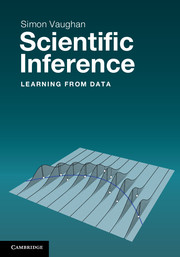Book contents
- Frontmatter
- Dedication
- Contents
- For the student
- For the instructor
- 1 Science and statistical data analysis
- 2 Statistical summaries of data
- 3 Simple statistical inferences
- 4 Probability theory
- 5 Random variables
- 6 Estimation and maximum likelihood
- 7 Significance tests and confidence intervals
- 8 Monte Carlo methods
- Appendix A Getting started with statistical computation
- Appendix B Data case studies
- Appendix C Combinations and permutations
- Appendix D More on confidence intervals
- Appendix E Glossary
- Appendix F Notation
- References
- Index
1 - Science and statistical data analysis
Published online by Cambridge University Press: 05 June 2014
- Frontmatter
- Dedication
- Contents
- For the student
- For the instructor
- 1 Science and statistical data analysis
- 2 Statistical summaries of data
- 3 Simple statistical inferences
- 4 Probability theory
- 5 Random variables
- 6 Estimation and maximum likelihood
- 7 Significance tests and confidence intervals
- 8 Monte Carlo methods
- Appendix A Getting started with statistical computation
- Appendix B Data case studies
- Appendix C Combinations and permutations
- Appendix D More on confidence intervals
- Appendix E Glossary
- Appendix F Notation
- References
- Index
Summary
It is remarkable that a science which began with the consideration of games of chance should have become the most important object of human knowledge.
Pierre-Simon Laplace (1812) Théorie Analytique des ProbabilitésWhy should a scientist bother with statistics? Because science is about dealing rigorously with uncertainty, and the tools to accomplish this are statistical. Statistics and data analysis are an indispensable part of modern science.
In scientific work we look for relationships between phenomena, and try to uncover the underlying patterns or laws. But science is not just an ‘armchair’ activity where we can make progress by pure thought. Our ideas about the workings of the world must somehow be connected to what actually goes on in the world. Scientists perform experiments and make observations to look for new connections, test ideas, estimate quantities or identify qualities of phenomena. However, experimental data are never perfect. Statistical data analysis is the set of tools that helps scientists handle the limitations and uncertainties that always come with data. The purpose of statistical data analysis is insight not just numbers. (That's why the book is called Scientific Inference and not something more like Statistics for Physics.)
Scientific method
Broadly speaking, science is the investigation of the physical world and its phenomena by experimentation. There are different schools of thought about the philosophy of science and the scientific method, but there are some elements that almost everyone agrees are components of the scientific method.
- Type
- Chapter
- Information
- Scientific InferenceLearning from Data, pp. 1 - 13Publisher: Cambridge University PressPrint publication year: 2013



